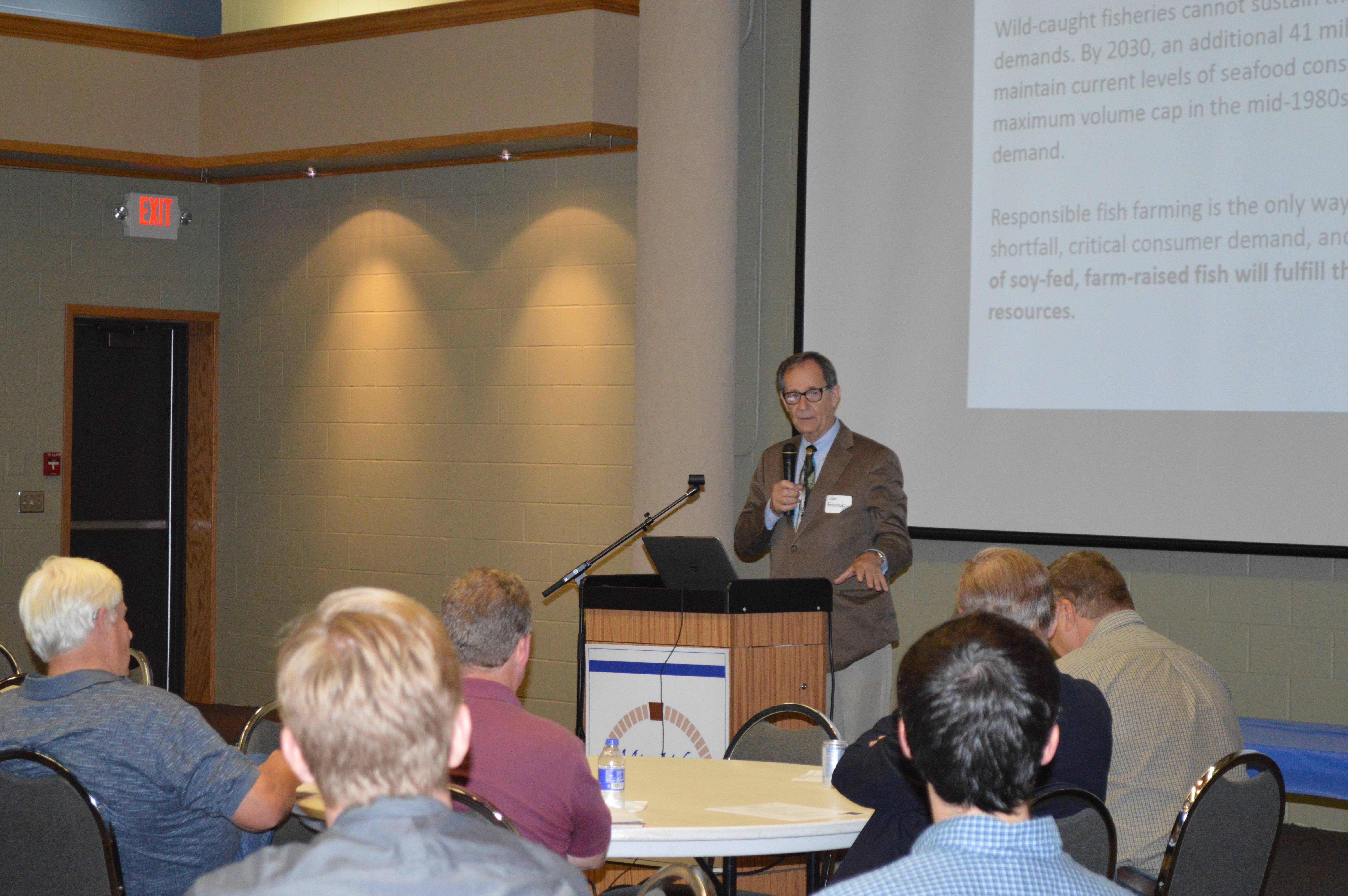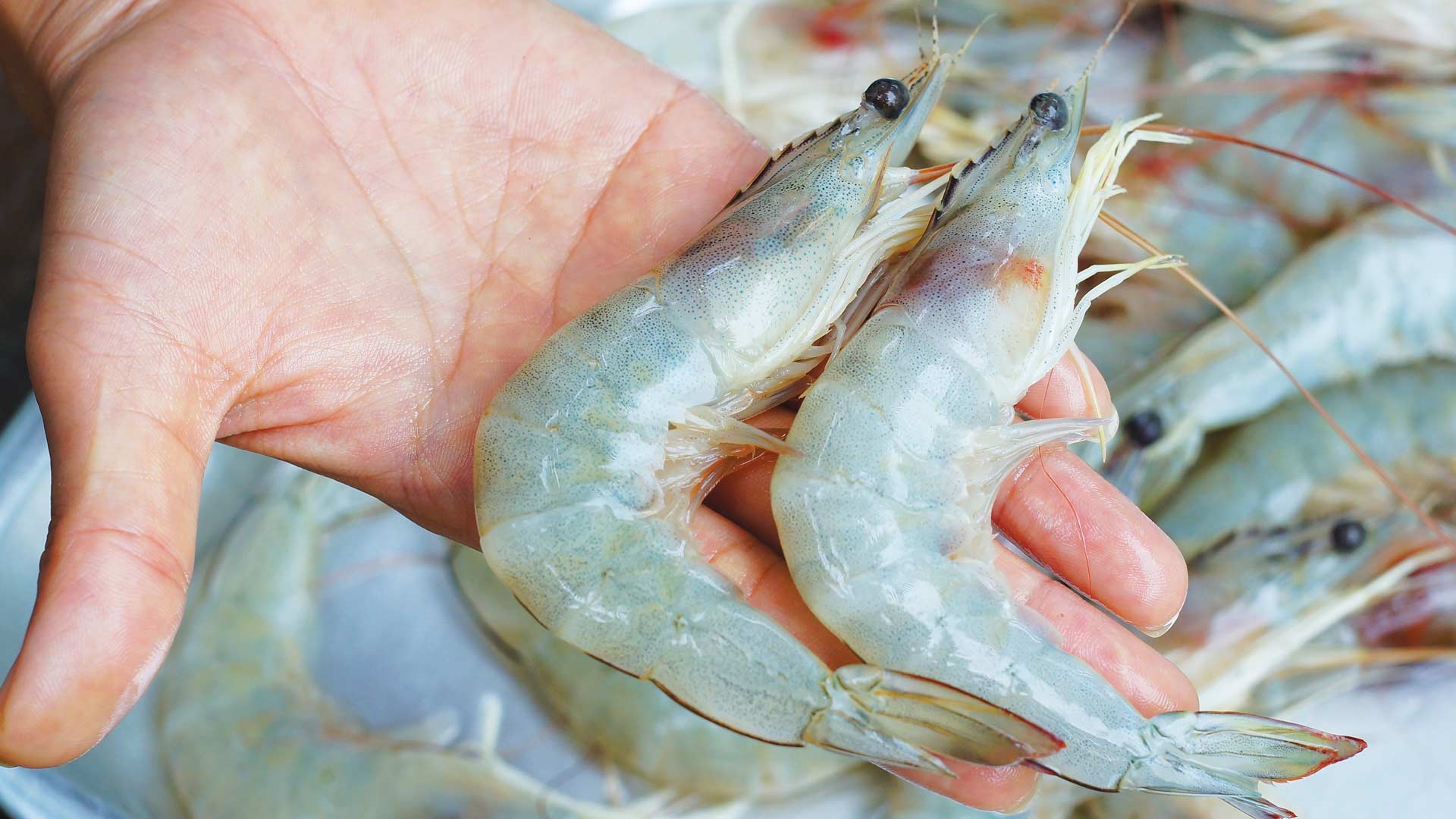–by Luke O’Neill
Minnesotans love seafood. While the state is home to the popular walleye, that’s not always what’s on the menu. According to the National Oceanic and Atmospheric Administration (NOAA), 90 percent of the U.S. seafood consumption is imported and most of that is shrimp. Per capita, Americans consume about 4.9 pounds of shrimp per year.
 About half of the seafood the U.S. imports is farm-raised. AURI recently partnered with the Minnesota Soybean Research and Promotion Council (MSR&PC) to convene experts in the field of inland fish and shrimp production for a forum examining opportunities for shrimp farming in Minnesota. The event took place at the MinnWest Technology Campus in Willmar and began with a welcome from Minnesota Department of Agriculture Commissioner Dave Frederickson.
About half of the seafood the U.S. imports is farm-raised. AURI recently partnered with the Minnesota Soybean Research and Promotion Council (MSR&PC) to convene experts in the field of inland fish and shrimp production for a forum examining opportunities for shrimp farming in Minnesota. The event took place at the MinnWest Technology Campus in Willmar and began with a welcome from Minnesota Department of Agriculture Commissioner Dave Frederickson.
The potential
How much could aquaculture benefit Minnesota’s economy? Nicholas Phelps, associate professor at the University of Minnesota’s School of Veterinary Medicine, explained that aquaculture is the fastest growing animal agriculture sector with trade of its products worth a whopping $130 billion in 2012. Aquaculture currently encompasses 181,000 jobs nationwide.
The potential for substantial growth exists but would require investment. Phelps concedes that barriers to expanding aquaculture operations within Minnesota and nationwide do exist. As interest in aquaculture products increases, stringent regulations will become a bigger part of the industry. Phelps added that aquaculture requires access to usable water and land, which may pose a problem in states currently with limited water supplies or shrinking farm land. Although those are important considerations and necessary challenges to overcome, Phelps said they do not represent insurmountable roadblocks.
“This need could be addressed by building out the value chain in the aquaculture industry to identify gaps and make them economic opportunities instead of unmet needs,” says Nan Larson, AURI’s director of innovative networks. “This event and the follow-up to occur is a great example of what AURI’s Innovation Network Program seeks to accomplish: bringing the right people together at the right time to lead to the commercialization of ideas, products, technologies and ultimately economic development in the value-added agriculture arena.”
Implementation
The next challenge for shrimp and fish production is implementation. Professor Emeritus Addison Lawrence, chief technical officer of trū Shrimp Systems, aquaculture specialist and world-renowned shrimp expert, has developed patented
technologies, feeds and methods for inland shrimp production. Lawrence is an industry pioneer, serving in many roles including project leader and scientist, at Texas A&M University.
“Aquaculture is our growth industry,” Lawrence said. “It is going to provide that needed, ample, extra protein source in the future.”
Moving shrimp production indoors allows for complete environmental control, which maximizes yield potential and limits exposure to potentially devastating diseases explained Lawrence.
Lawrence developed a raceway technology, which was patented by Texas A&M University System and licensed to Marshall, Minnesota-based trū Shrimp Systems of Ralco Nutrition, Inc., with the goal of making shrimp products as commercially prevalent and affordable as chicken.
This technology consists of a basin with continuously circulating currents that maintain water quality and promote robust shrimp production. Lawrence said this is vital because shrimp are susceptible to diseases and other potentially devastating biosecurity threats.
Compared to importing frozen fish, domestic aquaculture contributes to increased traceability within the seafood industry. This means that products can be more easily traced back to the source said Lawrence.
trū Shrimp Systems is currently building an expansive research facility in Balaton, Minnesota. In addition, they have developed a shrimp farm model title “Balaton Bay Harbor.” The model calls for multiple stacked raceways called “reefs.” The goal is to eventually build a shrimp farm near Tracy, Minnesota.
Shrimp could be fed a soybean-based diet. NutriVance, produced by Midwest Ag Enterprises, is derived from soybean meal, providing high-quality protein concentrate for fish and shrimp as well as other young animals. According to Jim Moline, President of Midwest Ag Enterprises, NutriVance is a superior alternative to traditional fish meal that will reduce feed costs, increase feed intake and facilitate growth. It will also provide another
market opportunity for Minnesota-grown soybeans.
The appeal
Mike Ziebell, general manager of trū Shrimp Systems, a division of Ralco, explained that inland shrimp production is well received by consumers for several reasons including excellent and consistent flavor, superior texture, alignment with organic or vegan product standards and a reduced carbon footprint.
 Soybean farmers could benefit as well, because 30 percent or more of every pound of shrimp feed comes from soybeans, a true value-add for the soybean industry, as well as other crop potential in Minnesota. Harold Stanislawski, AURI project development director indicated that the Ralco Minnesota aquaculture inland production model is a significant technological advancement in the industry with value-added benefits for Minnesota. Aquaculture offers an economic boost to state economies in sale of its products and the associated technologies.
Soybean farmers could benefit as well, because 30 percent or more of every pound of shrimp feed comes from soybeans, a true value-add for the soybean industry, as well as other crop potential in Minnesota. Harold Stanislawski, AURI project development director indicated that the Ralco Minnesota aquaculture inland production model is a significant technological advancement in the industry with value-added benefits for Minnesota. Aquaculture offers an economic boost to state economies in sale of its products and the associated technologies.
Other speakers shared their depth of knowledge with the group, including Paul Pierson from USDA, Dave Roeser from Garden Fresh Farms, and Zachary Robinson from Spark-Y.
AURI’s role
AURI is committed to developing new uses for agricultural products. Indoor aquaculture could be a new, emerging opportunity to add value and create new agricultural opportunities. “AURI is having an open mind and listening to everything that is going on in the agriculture, aquafeed and feeding industries,” said Moline. “It can only help us further our cause to develop products that are going to generate more added value back to our farmers.” “As we continue to grow and further progress, our company is going to create more jobsand more opportunities for Minnesota,” Moline adds.
